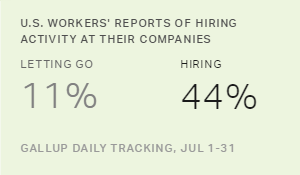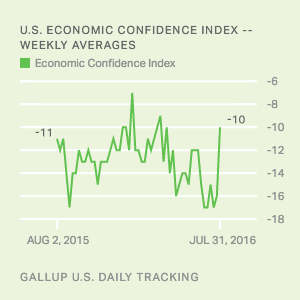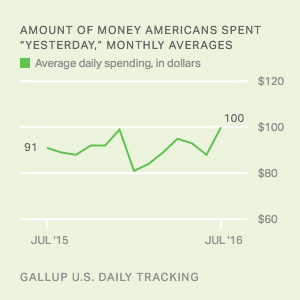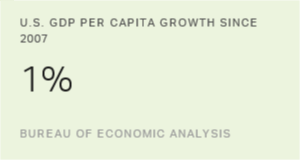Story Highlights
- U.S. Job Creation Index at +33 for third month in a row
- Gap narrowing between government and nongovernment hiring
WASHINGTON, D.C. -- U.S. workers' reports of hiring activity at their place of employment in July remained at a record high for the third month in a row. Gallup's U.S. Job Creation Index first reached the high score of +33 in its eight-year trend in May.

The latest holding pattern follows a period of relative stability in workers' perceptions of their employers' hiring activity. The index has ranged from +29 to +33 since February 2015.
Worker perceptions of hiring plummeted in 2008 amid that year's global financial crisis, resulting in more workers reporting layoffs rather than hiring at their places of employment between December 2008 and August 2009. Since then, perceptions of hiring have steadily improved, with the Job Creation Index climbing higher in each subsequent year before stabilizing in 2015. Index scores for 2016 so far have been slightly higher than those recorded by this point in 2015.
Gallup's Job Creation Index is based on employed U.S. adults' perceptions of their companies' hiring and firing practices. Gallup asks a random sample of employed adults each day whether their employers are hiring new people and expanding the size of their workforces, not changing the size of their workforces, or letting people go and reducing the size of their workforces. The resulting index -- computed by subtracting the percentage of employers letting workers go from the percentage hiring -- is nearly a real-time indicator of the nation's employment picture across all industry and business sectors.
In July, 44% of workers reported their companies were hiring, while 11% reported their companies were laying people off, resulting in the July Job Creation Index score of +33. These figures are unchanged from May and June. The latest results are based on interviews conducted July 1-31 with 16,753 full- and part-time U.S. workers.
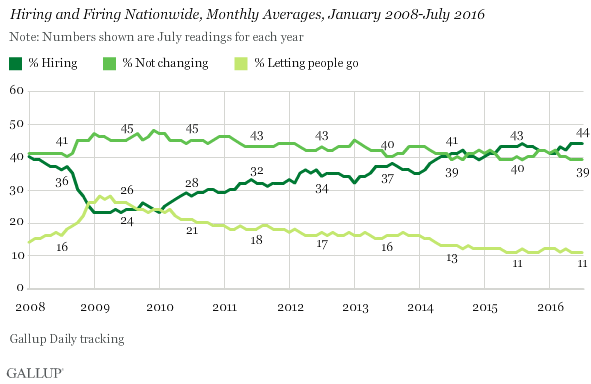
Gap Narrowing Between Government and Nongovernment Hiring
Government hiring increased for the third month in a row in July, to +31 -- the highest score for this sector in Gallup's trend. That increase had little effect on the overall Job Creation Index because the vast majority of U.S. workers are employed by nongovernment employers, among whom the July hiring index was +33, compared with +34 in June.
Net hiring scores among nongovernment workers have bested those of government workers for nearly all of Gallup's trend since late 2008, but that gap has narrowed recently. Net hiring plunged among both groups in late 2008, but nongovernment hiring recovered more quickly, returning to positive scores by late 2009 and steadily mounting thereafter. By contrast, net hiring among government workers remained in the red for three more years, turning positive only in late 2012.
Since then, government net hiring has been increasing at a faster pace than nongovernment net hiring, and the latest scores for each sector mark the closest the two have been since April 2009.
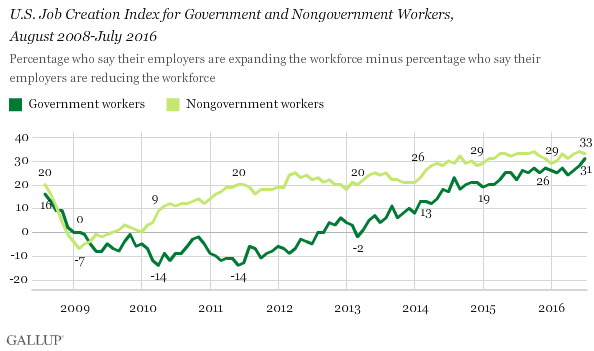
Bottom Line
Hiring activity in the U.S. remains at its best in eight years, according to U.S. workers themselves. This syncs with the Bureau of Labor Statistics' unemployment figures, which have been below 5% for most of 2016 so far. Gallup's Good Jobs measure is also healthy. The July update of the Good Jobs measure will be released on Thursday.
The private sector continues to provide the large majority of Americans' jobs, and hiring reports among private-sector workers remain strong. But government workers' reports are catching up and now barely trail those of nongovernment workers.
These data are available in Gallup Analytics.
Survey Methods
Results for this Gallup poll are based on telephone interviews conducted July 1-31, 2016, on the Gallup U.S. Daily survey, with a random sample of 16,753 workers, aged 18 and older, living in all 50 U.S. states and the District of Columbia. For results based on the total sample of workers, the margin of sampling error is ±1 percentage point at the 95% confidence level. All reported margins of sampling error include computed design effects for weighting.
Each sample of national adults includes a minimum quota of 60% cellphone respondents and 40% landline respondents, with additional minimum quotas by time zone within region. Landline and cellular telephone numbers are selected using random-digit-dial methods.
Learn more about how the Gallup U.S. Daily works.
